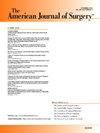The risk of preterm delivery after appendectomy during pregnancy is higher in the face of a negative appendectomy
IF 2.7
3区 医学
Q1 SURGERY
引用次数: 0
Abstract
Background
Reported outcomes after appendectomy during pregnancy remain inconclusive, and the risk for preterm delivery is not necessarily procedure-related.
Methods
This retrospective cohort study included 185 pregnant women who underwent appendectomy during pregnancy and gave birth between 2005 and 2022, compared using a 3:1 ratio to 555 parturients who did not undergo surgery. clinical, obstetrical and neonatal outcomes were analyzed.
Results
Laparoscopic appendectomy was the most common procedure (117/185; 63.2 %) whereas 68/185 (36.8 %) had open appendectomy. Pathological findings revealed that 141/185 cases (76.2 %) had an inflamed appendix, while 44/185 (23.8 %) were classified as having a “white appendix” (negative appendectomy).
Preterm delivery occurred more frequently in the appendectomy group [22/185 (11.9 %) vs 30/555 (5.4 %), p = 0.003] with even higher incidence in negative appendectomies compared to inflamed appendix cases [9/44 (20.5 %) vs 13/141 (9.2 %), p = 0.044]. Multivariate analysis identified appendectomy (but not an inflamed appendix) as the sole significant risk factor for preterm birth (odds ratio 2.3, CI 1.26–4.15, p = 0.006).
Conclusion
Preterm delivery correlates with negative appendectomies. Careful assessment is essential to avoid unnecessary surgical interventions during pregnancy.
妊娠期阑尾切除术后早产的风险在阑尾切除术阴性的情况下更高。
背景:报道的妊娠期阑尾切除术后的结局仍然不确定,早产的风险不一定与手术有关。方法:这项回顾性队列研究包括185名在2005年至2022年期间在怀孕期间接受阑尾切除术并分娩的孕妇,以3:1的比例与555名未接受手术的孕妇进行比较。分析临床、产科和新生儿结局。结果:腹腔镜阑尾切除术是最常见的手术方式(117/185;63.2%), 68/185(36.8%)行开腹阑尾切除术。病理结果显示141/185例(76.2%)为阑尾炎,44/185例(23.8%)为“白色阑尾”(阴性阑尾)。阑尾切除术组早产发生率更高[22/185 (11.9%)vs 30/555 (5.4%), p = 0.003],阴性阑尾切除术组的早产发生率高于炎症阑尾组[9/44 (20.5%)vs 13/141 (9.2%), p = 0.044]。多变量分析发现阑尾切除术(但不是阑尾发炎)是早产的唯一显著危险因素(优势比2.3,CI 1.26-4.15, p = 0.006)。结论:阑尾切除术阴性与早产相关。仔细评估是必要的,以避免不必要的手术干预在怀孕期间。
本文章由计算机程序翻译,如有差异,请以英文原文为准。
求助全文
约1分钟内获得全文
求助全文
来源期刊
CiteScore
5.00
自引率
6.70%
发文量
570
审稿时长
56 days
期刊介绍:
The American Journal of Surgery® is a peer-reviewed journal designed for the general surgeon who performs abdominal, cancer, vascular, head and neck, breast, colorectal, and other forms of surgery. AJS is the official journal of 7 major surgical societies* and publishes their official papers as well as independently submitted clinical studies, editorials, reviews, brief reports, correspondence and book reviews.

 求助内容:
求助内容: 应助结果提醒方式:
应助结果提醒方式:


